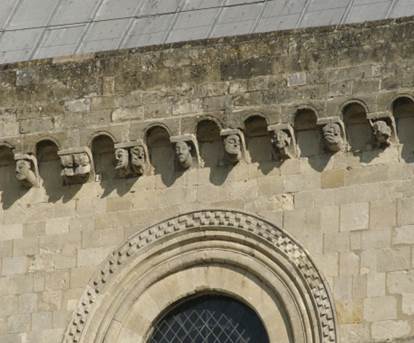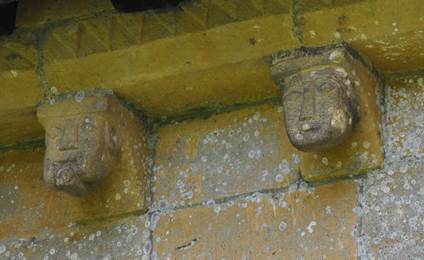
Highlights of the British Collection: East Oxford Archaeology
Object Biographies - Notes: A Stone Head from St. Clement's Oxford
by Nina Curtis
Notes
1. Accession record, no. 1912.2, Ashmolean Museum, Oxford, 1912.
2. St. Clement's is the name of a street and also of a parish/part of Oxford on the east side of the modern city, but just outside the ancient city boundary.
3. A corbel is a structural, solid piece of stone built into the fabric of a wall, but with part of it protruding from the wall (often in a bracket-like manner). It is designed to carry or support the weight of something resting on or overlying it, and was extensively used in medieval architecture and often decoratively carved. A corbel table is a row of corbels typically supporting lintels or small arches, and often sited just below the eaves of a roof to give extra support.

Medieval corbel table heads, Winchester Cathedral. Viewed on 05.06.2014.
https://wiki.uio.no/hf/ifikk/medieval_iconography/images/thumb/4/42/Winchester2.JPG/500px-Winchester2.JPG

Corbel Table Heads. Viewed on 05.06.2014.
http://farm9.staticflickr.com/8303/7921155224_9b388112d4_o.jpg
4. Marcus Cooper, interview with the author, Ashmolean Museum, 24 April, 2014.
5. W.J. Arkell, Oxford Stone (Faber and Faber, 1947), p. 22.
6. Arkell, Oxford Stone, p. 22.
7. Marcus Cooper interview.
8. Arkell, Oxford Stone, p. 46.
9. The dedication of a church to St. Clement is relatively uncommon in the British Isles (there are fewer than ten). St. Clement was a Roman, and was said to have been appointed by St. Peter as his successor in the late 1st century A.D. He was banished by the Emperor Trajan and set to work in a stone quarry where he performed a miracle by providing water for the labourers. He was subsequently martyred by being tied to an anchor and thrown into the Black Sea where he drowned. He became the Patron Saint of mariners, and the cult of St. Clement was based in Denmark. It is quite posible that there is a connection between this Oxford church and the settlement of Danes in Oxford in the Middle Ages.
A significant find close to the site of St. Clement's church would seem to firmly link this area of Oxford with Danish settlement. Laird and Viggers report that:
Metal objects and bones found near Magdalen Bridge in 1884 are
re-interpreted as the likely remains of a Viking warrior and his horse,
buried on an island in the Cherwell around the year 1000. . . . The man
probably belonged to one of the armies that raided the region from
the 990’s, or even to Swein Forkbeard’s army which attacked Oxford
in 1009 and 1013.
Oxford in the late tenth and early eleventh centuries had a
Danish Viking population. They were massacred, after taking
refuge in St Frideswide’s church in 1002 AD on St Brice’s Day.
As the report states: ‘It is significant that the burial was so
close to St Clement’s, the possible site of a Cnut period Danish
‘garrison’. St Clement was a favourite Viking saint and churches
with the St Clement’s dedication have been linked to Viking populations.”
J. Laird and M. Viggers, 'A Late-Viking Burial at Magdalen Bridge, Oxford? . . . revisited', in Archaeology of East Oxford website. Viewed on 14 April, 2014.https://www.archeox.net/sites/www.archeox.net/files/reports/Vikings%20in%20St%20Clement%20s.pdf
10. Lobel (ed.) 'Parishes: St. Clement's', in Victoria County History: A History of the County of Oxford, Vol. 5 (London: Oxford University Press, 1957), pp. 258-266.
11. List of Rectors of St. Clement's in the 13th Century
1232 Richard of St. Clement's
(before 1271) Richard de Bradewell
1271 Henry de Estria
1271 Hugh de Dadington
1273 M. Robert of Brackley
1275 William de Parvo Ponte
(before 1298) Hugh
1298 Henry de Norton
Typed document in collection of Oxfordshire History Centre, St Luke's Church, Cowley, Oxford.
12. Lobel (ed.) 'Parishes: St. Clement's', VCH pp. 258-266.
13. Oxford Archaeology, 'St Clement's Churchyard, The Plain, Oxford'. Archaeological Watching Brief Report, for Jacobs (Oxford Archaeology, October 2007), p. 3.
14. Lobel (ed.) 'Parishes: St. Clement's', VCH pp. 258-266.
15. Lobel (ed.) 'Parishes: St. Clement's', VCH pp. 258-266.
16. Lobel (ed.) 'Parishes: St. Clement's', VCH pp. 258-266.
17. Lobel (ed.) 'Parishes: St. Clement's', VCH pp. 258-266.
18. Some of the master masons also owned or leased their own quarries, thus ensuring additional income and influence. Freemasons tended to be amongst the more highly qualified workers, and they would prepare and dress the Freestone. Less skilled than the master and free masons were the layers, setters and wallers, who took the stones shaped by the freemasons and put them in place, and lower still were the rough masons, although Oxford college records show that they earned only slightly less money than the freemasons. Ordinary labourers would have earned about 4d. per day.
E.A. Gee, 'Oxford Masons 1370-1530', reprinted from The Archaeological Journal, Vol. CIX (Royal Archaeological Institute of Great Britain and Ireland: July, 1953), p. 58.
19. For example, Richard Winchcombe, Master Mason between 1398-1439, became the Master Mason for the Divinity School in Oxford in 1429, and his salary for that important position was 40s. a year 'with a gentleman's gown or the value in money (13s. 4d.), 4 s. a week while living in Oxford, a house for himself and his wife, fodder for a horse and travelling expenses.'
Gee, 'Oxford Masons', p. 69.
20. Alec Clifton-Taylor and A.S. Ireson, English Stone Building (Victor Gollancz in association with Peter Crawley, 1994), p. 84.
21. Gee, 'Oxford Masons', p. 58.
22. It would appear that almost every craftsman or tradesman was at some point prosecuted under the Statute of Labourers. The Black Death killed between 30%-50% of the population in Britain, resulting in a severe depletion in the labour supply. This meant that workers had greater bargaining power and the costs of labour increased, resulting in economic inflation. In 1351 Parliament passed the Statute of Labourers, which set a maximum wage for Labourers that was equal to the job rate before the Black Death, and also imposed penalties on those who were deemed to be idle:
Gee, 'Oxford Masons', p. 62.
23. The Statute decreed that: 'That every person, able in body and under the age of 60 years, not having enough to live upon, being required, shall be bound to serve him that doth require him, or else be committed to gaol until he shall find surety to serve, and that the old wages shall be given and no more . . . .' This statute was of course extremely unpopular with the work force.
'The Statute of Laborers, 1351', in The Avalon Project: Medieval Documents (Yale Law School/Lillian Goldman Law Library). Viewed on 9 April, 2014. http://avalon.law.yale.edu/medieval/statlab.asp
24. Gee, 'Oxford Masons', p. 60.
25. Stephanie Jenkins, 'The Stone Quarries', in Headington Community website: 'History: Miscellaneous', viewed on 2 April, 2014. https://www.headington.org.uk/history/quarries/index.html
26. 'The traditional way of quarrying soapstone', in Per Storemyr Archaeology and Conservation: Experimental Archaeology' website. Viewed on 15 April, 2014. http://per-storemyr.net/2011/09/04/experimental-archaeology-the-traditional-way-of-quarrying-soapstone/.
27. Marcus Cooper interview.
28. Clifton-Taylor and Ireson, English Stone Building, p. 86.
29. Clifton-Taylor and Ireson, English Stone Building, , pp. 88-89.
30. Marcus Cooper interview.
31. Gee, 'Oxford Masons', p. 57.
32. If the head is male, as seems likely, then does it represent a particular figure, or is it generic? This is something we will probably never know, but there is also the possibility that it is female, and that presents an intriguing scenario.
St. Frideswide (c. 650 – 727 A.D.) is the Patron Saint of Oxford, as well as being intimately connected with St. Clement's Church through the ownership of the manor' by St. Frideswide's from the early part of the 11th century and of the church since the 12th century. She was a princess, but also an abbess, and is often depicted in art as wearing a wimple, with a neckpiece similar to that found on the head (although her wimple is always shown as including the head piece, and our head does not appear to have a head covering).
The Priory buildings (now the site of Christ Church Cathedral) were destroyed in 1002, in the fighting that took place on the St. Brice's Day Massacre, when significant numbers of Danish residents of Oxford were killed on the orders of King Aethelred the Unready. Given that there is a strong possibility of a link between St. Clement's Church and the settlement of Danes in Oxford, is it possible that when St. Frideswide's assumed responsibility for St. Clement's church 120 years after the massacre, that Church elders ordered the head to be carved and installed in the church, in an attempt to reinforce the presence of the English saint there, and to sever any connection to the Danes that still persisted in the church?
33. Oxford Archaeology, 'St Clement's Churchyard, The Plain, Oxford'. Archaeological Watching Brief Report, for Jacobs (Oxford Archaeology, October 2007. p. 15.
July 2014
